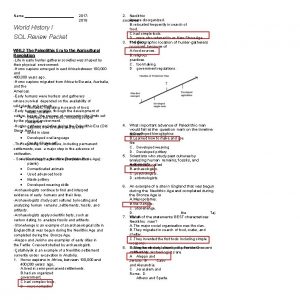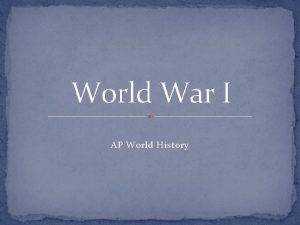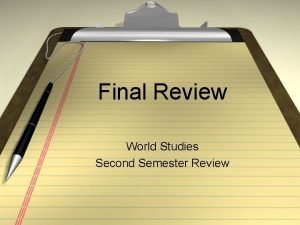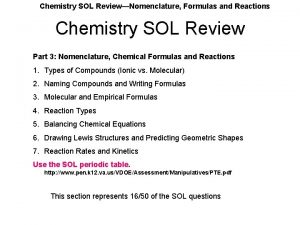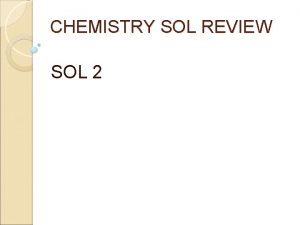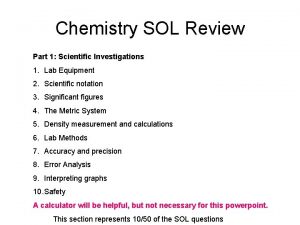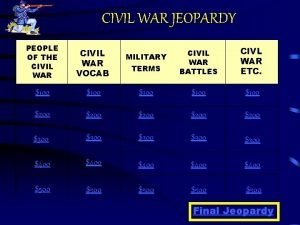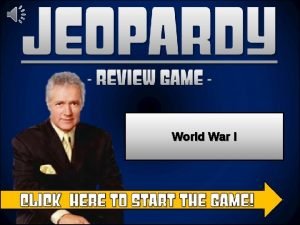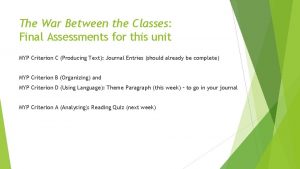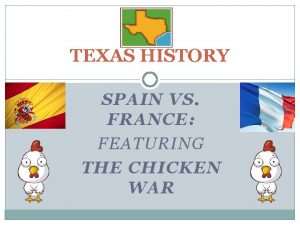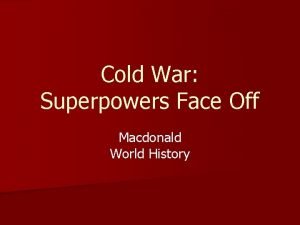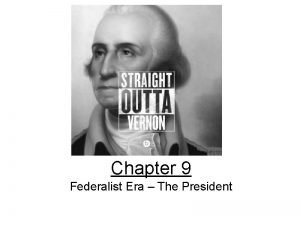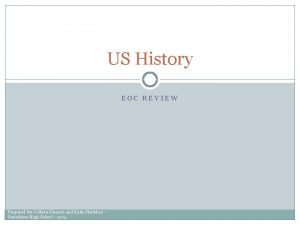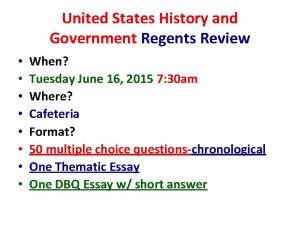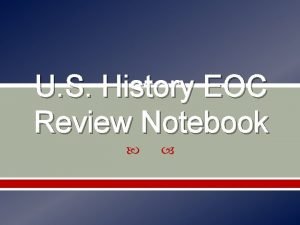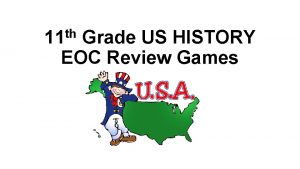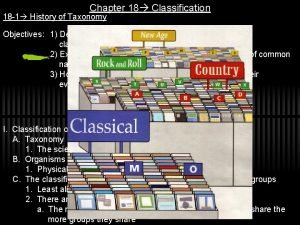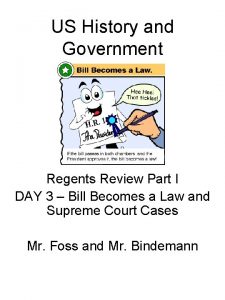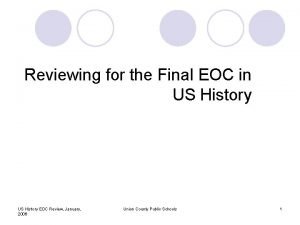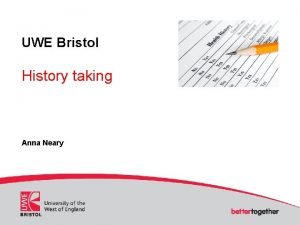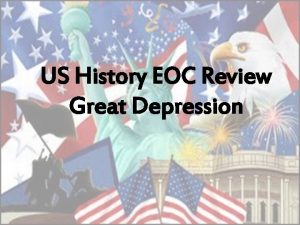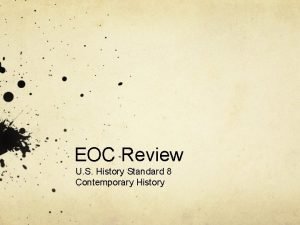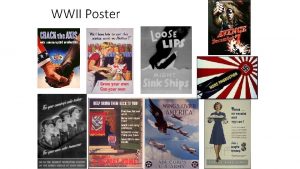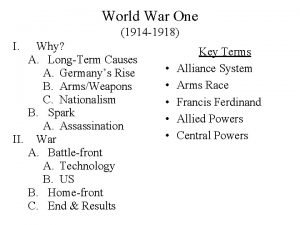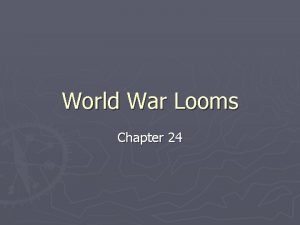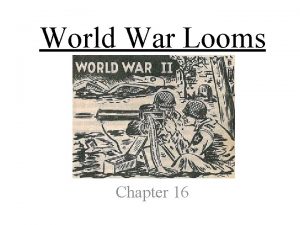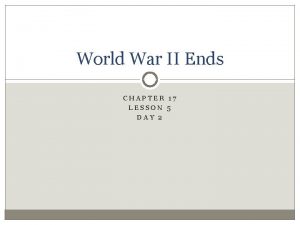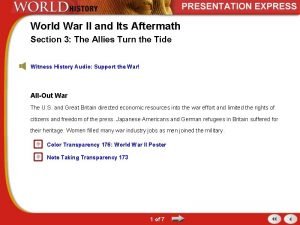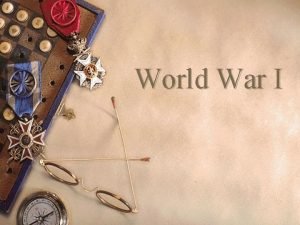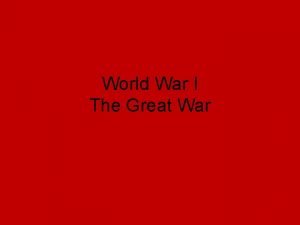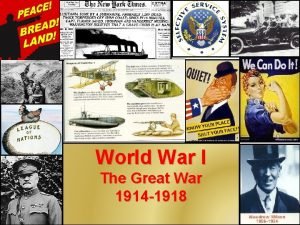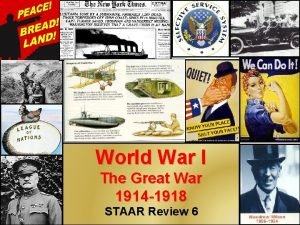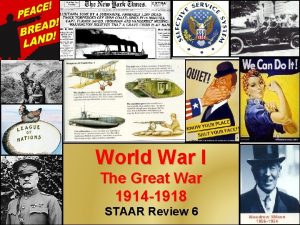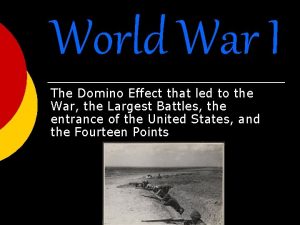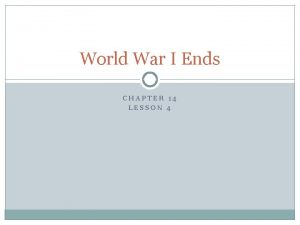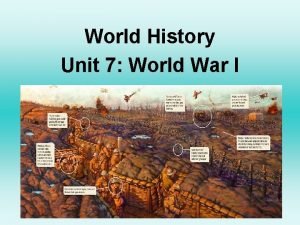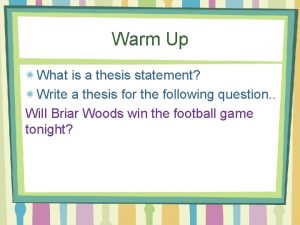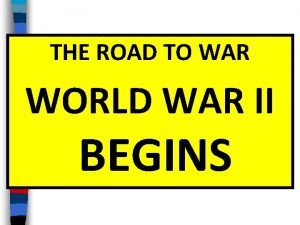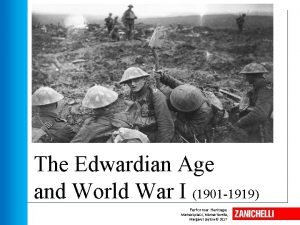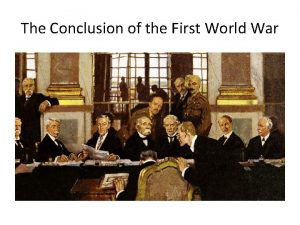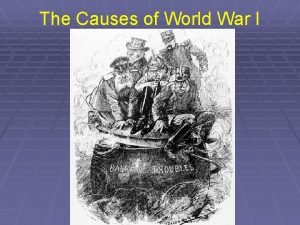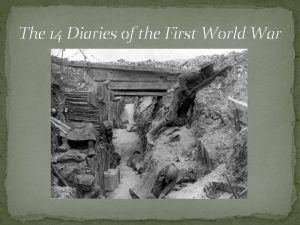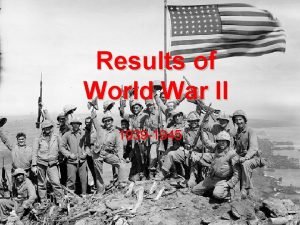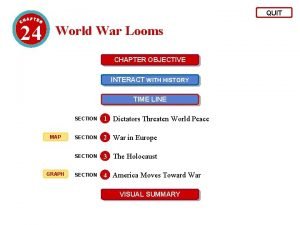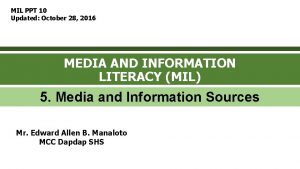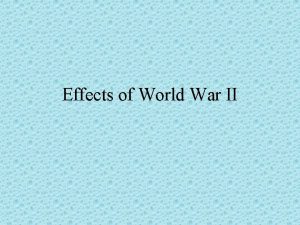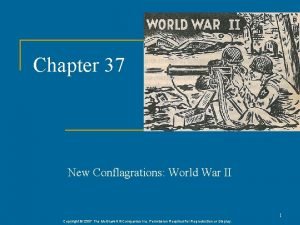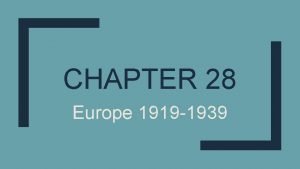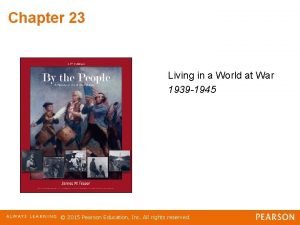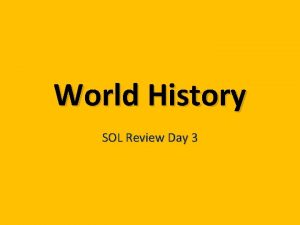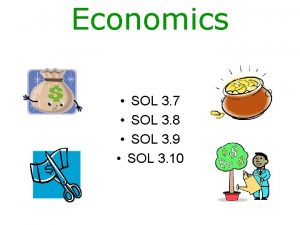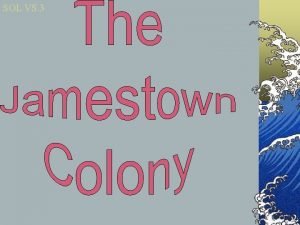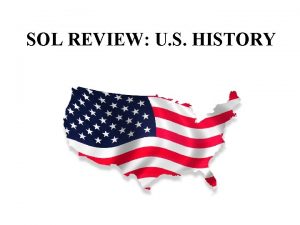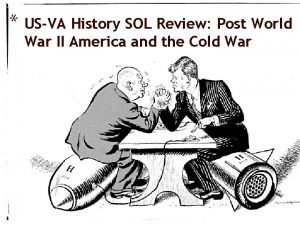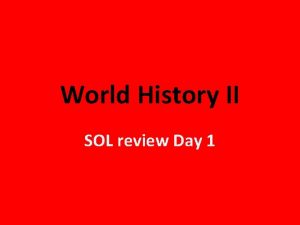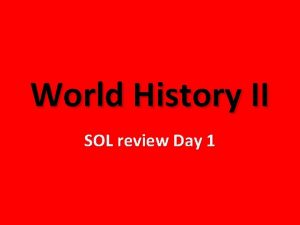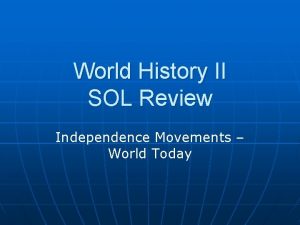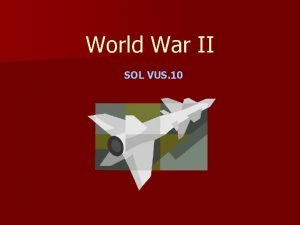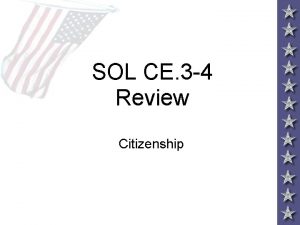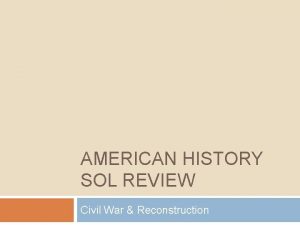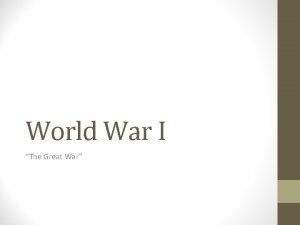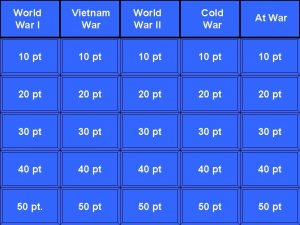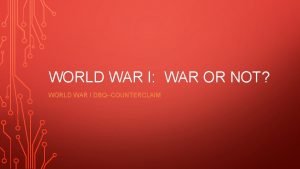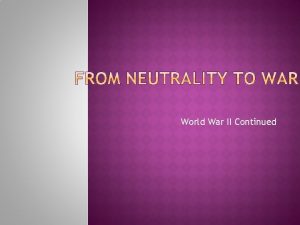World History II SOL Review World War II




































































































- Slides: 100

World History II SOL Review World War II and the Cold War

Page 490 -518 Causes of World War II

Totalitarian Dictators Nationalism U. S. Isolationism and Pacifism Treaty of Versailles Failure of the League of Nations Appeasement Causes of World War II

Battles and Events of World War II Event/Battle Date The 9/1939 Invasion of Poland Purpose Take over Europe and Poland Outcome Britain had previously warned Hitler that any aggression towards Poland would not be tolerated. Hitler ignored the threat, invaded Poland successfully, but found itself now at war with Britain and France. The Fall of France 6/1940 Conquer France, Western Europe Having either allied itself or conquered many other neighboring countries, Germany looked towards France. Germany won control of France and Hitler had almost all of Europe under his control. Hitler’s next move would be eliminate any threat from Great Britain. Battle of Britain 9/1940 Destroy British air power and air industry Bombed day and night, the British people refused to give in to Hitler’s Luftwaffe. Britain won ending a threatened German invasion of Britain. Invasion of 6/1941 the Soviet Union Living space and resources Russia wins, aided by a harsh Soviet winter

Battles and Events of World War II Event/Battle Date Purpose Outcome Pearl Harbor 12/7/ 1941 Destroy American military power Brings US into the war D-Day (Allied Invasion of Normandy) 6/6/ 1944 Land troops in France to then invade Germany Since Hitler’s German army controlled almost all of Europe, it was difficult to get troops onto the continent. However, led by Dwight E. Eisenhower, the Allies planned and successfully carried out the invasion of Normandy, France. With the Allied victory, they can now fight back and invade Germany. Yalta Conference 2/1945 Decide what to M. A. G. I. C. do with Europe (see M. A. G. I. C slides) after WWII Hiroshima and Nagasaki 8/1945 Swiftly end the war with Japan In an effort to quickly end the war with Japan and save American lives, President Truman decided to drop two atomic bombs, one each on the cities of Hiroshima and Nagasaki. Japan surrenders.

T The shades of purple show the areas either allied with or occupied/ controlled by the Axis powers. The green areas represent the Allied powers. Now do you understand the significance of the invasion of Normandy?

Fall of France Attack on Pearl Harbor Quote by Winston Churchill in reference to the pilots of the Royal Air Force (RAF) who were defending the British people during the Battle of Britain.

June 6, 1944: D-Day The Invasion of Normandy The invasion was led by this man, General Dwight D. Eisenhower Allied soldiers approaching the coast of Normandy


The Atomic Bomb

Important People Eisenhower: American general in charge of D-Day invasion Roosevelt: American president at the outbreak of the war

Truman: American President at the end of the war Makes the decision to drop the atomic bomb Churchill: British Prime Minister

Stalin: Soviet Dictator

Hirohito: Japanese emperor Tojo: Japanese general Hitler: Nazi German leader

Mac. Arthur: American general, Philippine campaign and postwar Japan Marshall: American general, top advisor to Roosevelt

The Holocaust “Work Will Set you Free”

Events leading up to the Holocaust • The Holocaust is partially a result of thousands of years of hatred of Jews • 1. Totalitarianism + nationalism + industrialization belief in the Holocaust • 2. European legacy of anti-Semitism • 3. defeat in World War I and the Great Depression blamed on the Jews • 4. Hitler’s belief in the “master” race – Aryan • 5. Final Solution – systematic attempt to remove all Jews from the face of the Earth – death camps, gas chambers

Genocide: the systematic attempt to eliminate a group of people from the face of the earth The map to the right and the next slide show other examples of genocide


Outcomes of World War II Loss of empires by European powers Establishment of two major powers in the world: The United States and the U. S. S. R. War crimes trials Division of Europe: Iron Curtain The Universal Declaration of Human Rights The Marshall Plan Formation of the North Atlantic Treaty Organization and the Warsaw Pact

Outcomes of World War II Loss of empires by European powers Establishment of two major powers in the world: _______________________ Division of Europe: _____________________________ ____________________________________________




And that’s how the U. S. used M. A. G. I. C. to fix West Gem any and Japan after World War II.

INTERNATIONAL COOPERATIVE ORGANIZATIONS

The United Nations • Somewhat like the League of Nations, the United Nations was formed to prevent future wars. • The UN has more power than the League of Nations did. And yes, the United States is a member.

North Atlantic Treaty Organization (NATO) • Defensive Alliance (1949) – Western Europe – United States, Canada • Resist invasion by Soviet Union • Collective security – “Attack on one is an attack on all”

Warsaw Pact • Defensive pact between Soviet Union and its Eastern European satellite nations • Response to NATO

Universal Declaration of Human Rights • Established and adopted by members of the United Nations • Provided a code of conduct for the treatment of people under the protection of their government

1. 2. 3. 4. 5. 6. 7. 8. Follow Up Questions What was the Marshall Plan? Who was Douglas Mac. Arthur? Identify at least two things he did. After WWII, the Allies limited the militaries of Japan and Germany. How was the security of these countries guaranteed? How was the treatment of the defeated powers different in WWII than it was in WWI? How was the U. N. different from the League of Nations? Identify the Warsaw Pact and NATO. What are these examples of? Have they caused problems in the past? What is a “satellite nation”? What was the UDHR? Why was it created?

THE COLD WAR

Beginning of the Cold War (1945 – 1989) • Definition – Period of time between 1945 and 1989 or 1991 when the United States and U. S. S. R. faced off in a clash of two different ideologies. • Intense competition for control of the world

Cold War (1945 – 1989) • United States represented – democracy – free market economic system – individual freedoms • Union of Soviet Socialist Republics – totalitarian government – communist (socialist) economic system – no freedoms

Yalta – February 1945 • Big Three – Franklin D. Roosevelt (U. S. ), Joseph Stalin (U. S. S. R. ), and Winston Churchill (G. B. ) met to discuss the future of postwar Europe

The Big Three

Post War Germany • Big Three agree to divide Germany into four sections • -- British • -- American • -- Russian • -- French

Post War Germany • Original plan to unite all four zones – One nation – Berlin capital • Russians refuse • Uh-oh…

West Germany • Britain, France, and the United States unite their zones • Western zones – Resume selfgovernment – Liberal democracy – Pro-United States – Capitalist • Russian dominated zone • Eastern zones • -- Puppet regime controlled by the U. S. S. R. – satellites • -- Communist/totalitarian government • -- Pro-Soviet • -- Communist/command economy East Germany

Berlin • Located in East Germany • Former capital also divided among four allied powers • Located in Russian zone – West Berlin capital of West Germany – East Berlin Capital of East Germany

Eastern and Central Europe • Stalin promised “free” elections in Eastern and Central Europe at Yalta in 1945 • Post-War – Occupied by Soviet Union • After elections all become communist – Satellite Nations Puppets controlled by Soviet Union – “Iron Curtain” – nicknamed by Winston Churchill in a famous speech


Marshall=MONEY Marshall Plan (1947) • United States offers financial aid to Europe • Eastern Europe refuses (why? !) • Rebuilds Western European economies – Stop spread of communism through “friendship” (how? !) What does this cartoon mean?

Recipients: Marshall Plan 1. Who gets most of the money? 2. Why do those countries receive money? 3. What countries do not receive money? 4. Why?

COLD WAR CONFLICTS

Truman Doctrine (1947) • Containment of Communism – Goal is to resist spread not roll back communism – Aid to Greece and Turkey Harry S. Truman Josef Stalin

Space Race • U. S. Government goes crazy due to the successful launch of… • Soviet Union – Sputnik – First satellite

Berlin Wall (1961)

Berlin Wall (1961) • Separates Soviet East Berlin from Western Zone • Attempt to prevent flight of East Germans to West • Symbol of Cold War

Construction of Berlin wall, 1961

Berlin Wall

Berlin Wall

“Checkpoint Charlie” – gateway between East and West Berlin

Nuclear Threat • Soviet Union and the United States matched nuclear weaponry during the 1950 s • Threat of nuclear war ever present • U. S. S. R. uses espionage to quickly copy U. S. nuclear power

Nuclear Threat • President Eisenhower adopted a policy of “massive retaliation” to deter any nuclear strike by the Soviets. • Theory of Deterrence

• Increases threat of nuclear war

Cold War Conflict: Cuba Khrushchev and Kennedy, 1962 13 Days

Cuba (1950 s) • In the 1950’s, a U. S. -led dictator was in charge of Cuba • Fidel Castro led a communist revolution that took over Cuba in the 1950 s – Many Cubans fled • U. S. wants control of Cuba back • Why?

Cuban Missile Crisis 1962 • To get back at the U. S. and to gain financial support, Fidel Castro allies with the Soviet Union • Soviet Union stationed missiles in Cuba • U. S. spy planes catch the Soviets in the act

Cuban Missile Crisis

Cuban Missile Crisis • President Kennedy ordered the Soviets to remove their missiles – Brinkmanship – go right to the edge of nuclear war, but do not go over it – for 13 days the world was on the brink of nuclear war – quarantine of Cuba (blockade) – Khrushchev backs down – nuclear war averted – Closest U. S. and U. S. S. R. ever came to nuclear conflict!

Fighting Communists in… China Korea Vietnam

China: Must Knows Conflicts and Revolution in Division of China into two nations at the end of the Chinese civil war Chiang Kai-shek Nationalist China (island of Taiwan) Mao Tse-tung (Mao Zedong) Communist China-Mainland China Continuing conflict between the two Chinas Communist China’s participation in Korean War Mao Zedong Details…

Chinese Civil War (1945 -1949) MOLE! Mao! • Communists – Mao Zedong • Nationalists – Chiang Kai-Shek VS! (Mao Tse-Tung) (Jiang Jieshi)

Chinese Civil War (1945 -49) • After World War II, Nationalists vs. Communists • Communists WIN!!! – Mao Zedong takes over mainland China • Nationalists LOSE!!! – Chiang Kai-Shek forced to move to Taiwan

Chinese Civil War (1945 -1949) MOLE! Mao! • Communists – Mao Zedong • Nationalists – Chiang Kai-Shek VS! (Mao Tse-Tung) WINNER!!! (Jiang Jieshi) LOSER!!!

United States – Chinese Relations (1940 s 1950 s) • During WWII, U. S. allies with China (led by Chiang Kai-Shek) to defeat Japan. • So…during the Chinese Civil War, U. S. backs Nationalists and Chiang Kai-Shek • (Why? ) • After the Chinese Civil War, U. S. supports Taiwan (Nationalists!), and promises protection from an invasion by Communist China • Communist China and Democratic Taiwan hate each other to this day, and U. S. is in the middle!

U. S. – Chinese Relations (1980 s-present) • Deng Xiaoping • Four Modernizations – transformed Chinese economy • Poor agricultural communism some capitalist industry • Ex. Some private businesses, but majority of business are controlled by the gov’t • Effects: China’s market economy leads to rapid economic growth • Effects: Still no political freedoms due to totalitarian/communist control Deng Xiaoping – held out the carrot that has led Western business into China!

Cold War (1945 – 1989) Anti-Communist strategy of containment in Asia led to America’s involvement in two war Korean War Key Terms Communist invasion 38 th Parallel Douglas Mac. Arthur Stalemate Vietnam War Key Terms Containment Domino Theory Ho Chi Minh

Korean War (1950 -1953) • American involvement in Korea reflected the policy of containment • Post-World War II 38 th parallel divided peninsula – communist North – democratic South

Korean War (1950 – 1953) • June 25, 1950 North Korea invaded South Korea • United Nations calls for member nations to help South Korea

Korean War (1950 – 1953) Cool History Fact: U. S. military desegregated during the Korean War – first in U. S. history! • United States and United Nations forces under General Mac. Arthur push invaders towards the Chinese border • China enters war on side of North Korea • War ends in a stalemate at the 38 th parallel • North Korea (communist) still divided from South Korea (democratic) today!

VIETNAM WAR

Vietnam: Must Knows Role of French Imperialism Leadership of Ho Chi Minh Vietnam as a divided Nation Influence of the policy of containment The United States and the Vietnam War Vietnam as a reunited communist country today Details…

NOTE: The SOL Test may not ask you about all the specific details given in the next few slides, but they help students to gain a better understanding of the Vietnam War • French Imperialism in Southeast Asia leads to: – Nationalist independence movements – Ho Chi Minh – communist leader of the Vietnamese nationalists against the French • Vietminh League • Seek independence following WWII

Vietnam War • United States gives aid to French fighting the communists • Why?

Vietnam War • Domino Theory – U. S. theory developed as a result of containment – if one country falls to communism, then the surrounding countries will also become communist (fall over like dominoes)

Vietnam Civil War – Ho Chi Minh leads Vietminh to huge victory over France – Vietnam divided into North Vietnam (communist) and South Vietnam (democrat? ) – United States takes over helping South Vietnam due to domino theory – President Kennedy in the early 1960 s

Vietnam War • South Vietnamese government seen as corrupt and unpopular • Diem – South Vietnamese leader – really a brutal dictator • Still receives U. S. support Self-immolation as protest

President Nixon • President Nixon was elected on a pledge to bring the war to an honorable end • Vietnamization (1975) – Nixon’s plan to withdraw U. S. troops – replace them with South Vietnamese forces using American equipment – Sound familiar?

South Vietnam Falls (1975) • South Vietnamese troops proved unable to resist invasion by the Soviet supplied North Vietnamese army

Internal and external pressures caused the collapse of the Soviet Union ENDING THE COLD WAR

Internal Economic inefficiency Economic collapse Internal Rising Nationalism in Soviet Republics Collapse of the U. S. S. R. End of Cold War Fall of the Berlin Wall (1989) NATO Expansion Break up of Soviet Union (1991)

Collapse of Soviet Union – internal 1. Rising nationalism in Soviet Republics Warsaw Pact Poland – Solidarity movement Hungary

Collapse of Soviet Union – internal 2. • Fast-paced reforms – (market economy) • Economic inefficiency economic collapse

Collapse of Soviet Union – internal • Increasing Soviet military expenses to compete with the United States

Collapse of Soviet Union – internal • President Gorbachev – last president of the U. S. S. R. • Tried to stop the Soviet collapse by using Western ideas – “glasnost” • Openness • More personal freedoms – “perestroika” • economic restructuring • Some forms of capitalism allowed in the U. S. S. R. Birthmark on forehead = can tell who he is

The Soviet economy is collapsing – communist totalitarianism not working as economic system Last president of U. S. S. R. – tried to stop collapse Perestroika = “economic Glasnost = Gorbachev restructuring” “openness” More capitalism More freedoms Mikhail Cold War – wants to stop the Soviet Union Evil Empire Ronald Reagan and the U. S. pressured Gorbachev to make decisions “Mr. Gorbachev – tear down this wall. ” Ronald Increased U. S. military Reagan spending Wall probably going to come down anyway

Collapse of Soviet Union – internal 3. break up in 1991!

Collapse of the Soviet Union 4. • Leads to an expansion in the number of countries in NATO • Area in light blue, NATO countries in Europe today

NATO

President Reagan • Ronald Reagan • Challenged moral legitimacy of the Soviet Union • “Mr. Gorbachev, tear down this wall”

Fall of Berlin Wall (1989) 5. Fall of Berlin Wall in 1989

Fall of Berlin Wall

President Reagan • Increased U. S. military pressure on the Soviet Union

President Reagan • Increased U. S. economic pressure on the Soviet Union

Cold War – wants to end it as soon as possible! British prime minister in the 1980 s – friend of Reagan, anti-U. S. S. R. Free trade Less gov’t regulation Margaret Thatcher Military buildup Close personal ties/political conservative with Reagan and U. S.

Cold War Timeline

End of the Cold War Superpowers Sole Superpower 1945 - 1989 - ?

YOU!!! Are an SOL Power
 World history 1 sol review packet
World history 1 sol review packet History sol review
History sol review Contoh sol koloid
Contoh sol koloid Total war world history definition
Total war world history definition World history spring final exam review answers
World history spring final exam review answers World history semester 2 final review packet
World history semester 2 final review packet World history b semester exam review practice
World history b semester exam review practice Ap world history 600 to 1450 review
Ap world history 600 to 1450 review World history chapter 6 review
World history chapter 6 review World history fall final review answers
World history fall final review answers Us history semester 1 final exam study guide answers
Us history semester 1 final exam study guide answers Ap world history jeopardy review game
Ap world history jeopardy review game Ap world history final exam
Ap world history final exam 4th grade va studies sol
4th grade va studies sol Geometry sol review packet
Geometry sol review packet Geometry sol review packet
Geometry sol review packet Earth science sol
Earth science sol Sol review algebra 1
Sol review algebra 1 Civics sol review
Civics sol review Kuhinjska sol formula
Kuhinjska sol formula Chemistry sol review
Chemistry sol review Chemistry sol review
Chemistry sol review Chemistry sol review
Chemistry sol review Biology sol review
Biology sol review Chemistry sol review
Chemistry sol review Earth science final exam review
Earth science final exam review Chemistry sol review
Chemistry sol review Ap world history chapter 25 africa and the atlantic world
Ap world history chapter 25 africa and the atlantic world Dangerous world tour setlist
Dangerous world tour setlist What challenges did madison face abroad
What challenges did madison face abroad Description
Description The cold war lesson 1
The cold war lesson 1 Presidential and congressional reconstruction venn diagram
Presidential and congressional reconstruction venn diagram Why did josette dugas want to go to war
Why did josette dugas want to go to war Sein datid
Sein datid Study jams force and motion
Study jams force and motion Civil war first modern war
Civil war first modern war Ich war du warst er sie es war
Ich war du warst er sie es war Chapter 16 lesson 2 challenges to slavery
Chapter 16 lesson 2 challenges to slavery Proxy wars in the cold war
Proxy wars in the cold war Chapter 30 the war to end war
Chapter 30 the war to end war Chapter 30 the war to end war
Chapter 30 the war to end war What is gettysburg
What is gettysburg Wwi jeopardy
Wwi jeopardy The war between the classes review
The war between the classes review Chicken war texas history
Chicken war texas history History of cold war
History of cold war The federalist era lesson 3
The federalist era lesson 3 Chapter review motion part a vocabulary review answer key
Chapter review motion part a vocabulary review answer key Uncontrollable spending ap gov
Uncontrollable spending ap gov Nader amin-salehi
Nader amin-salehi Systematic review definition
Systematic review definition Narrative review vs systematic review
Narrative review vs systematic review Florida us history eoc review
Florida us history eoc review Us history regents review
Us history regents review Us history eoc review notebook
Us history eoc review notebook 11 grade us history eoc review
11 grade us history eoc review Https //kahoot..com
Https //kahoot..com Section 18-1 review history of taxonomy
Section 18-1 review history of taxonomy Us history semester 2 review
Us history semester 2 review Us history regents practice
Us history regents practice Semester 1 final exam study guide us history
Semester 1 final exam study guide us history Us history
Us history Day 1 us history eoc review
Day 1 us history eoc review Unit 1 test review us history
Unit 1 test review us history Oldcarts
Oldcarts Us history eoc review the great depression and the new deal
Us history eoc review the great depression and the new deal 8 contemporary court
8 contemporary court Systematic review in history taking
Systematic review in history taking Also history physical
Also history physical Propaganda techniques poster
Propaganda techniques poster Results of the world war 1
Results of the world war 1 Chapter 16 world war looms vocabulary
Chapter 16 world war looms vocabulary Chapter 16 world war looms vocabulary
Chapter 16 world war looms vocabulary Lesson 5 world war 2 ends
Lesson 5 world war 2 ends World war 2 and its aftermath section 1 quiz
World war 2 and its aftermath section 1 quiz What was the immediate cause of world war i brainpop
What was the immediate cause of world war i brainpop Chapter 27 world war 1 and the russian revolution
Chapter 27 world war 1 and the russian revolution The big four ww1
The big four ww1 4 causes of ww1
4 causes of ww1 What was the cause of world war 1
What was the cause of world war 1 Cause of world war 1
Cause of world war 1 The domino effect ww1
The domino effect ww1 Chapter 27 lesson 4 world war 1 ends
Chapter 27 lesson 4 world war 1 ends Triple entente countries in world war 1
Triple entente countries in world war 1 A thesis statement is
A thesis statement is Ww2 causes
Ww2 causes From the edwardian age to the first world war zanichelli
From the edwardian age to the first world war zanichelli World war 1 conclusion
World war 1 conclusion Long term causes of ww1
Long term causes of ww1 What was the cause of world war 1
What was the cause of world war 1 Arte 14 - diaries of world war i
Arte 14 - diaries of world war i Results of the world war 1
Results of the world war 1 Chapter 24 world war looms section 1 answers
Chapter 24 world war looms section 1 answers School uniform of sshs prior to the second world war
School uniform of sshs prior to the second world war Result of world war 2
Result of world war 2 Conclusion of ww1
Conclusion of ww1 Chapter 37 new conflagrations world war ii
Chapter 37 new conflagrations world war ii Schutzstaffen
Schutzstaffen World war looms chapter 24
World war looms chapter 24 Chapter 23 living in a world at war
Chapter 23 living in a world at war
